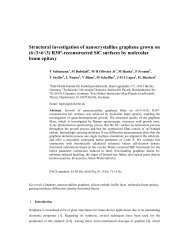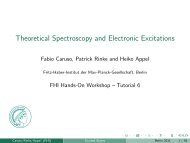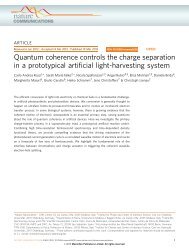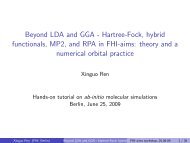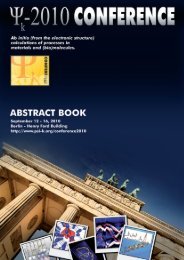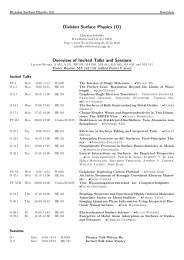A one-dimensional ice structure built from pentagons - Theory ...
A one-dimensional ice structure built from pentagons - Theory ...
A one-dimensional ice structure built from pentagons - Theory ...
Create successful ePaper yourself
Turn your PDF publications into a flip-book with our unique Google optimized e-Paper software.
ARTICLES<br />
NATURE MATERIALS DOI: 10.1038/NMAT2403<br />
a<br />
b<br />
7.2 Å<br />
5.4 Å<br />
c<br />
[001]<br />
[110]<br />
[110]<br />
[001]<br />
Figure 1 | Experimental STM images of water on Cu(110). a, STM image taken at 100 K showing water chains growing along the [001] direction<br />
(120×140 Å, V = −196 mV, I = −0.63 nA). b, Expansion of a showing partial resolution of the water <strong>structure</strong> within the chain (38×35 Å). c, Image<br />
showing protrusions residing between the Cu rows in the [001] direction (50×30 Å, V = −196 mV, I = −0.34 nA).<br />
a b c d<br />
2.58<br />
3.62<br />
7.2<br />
7.2<br />
7.0<br />
5.9<br />
6.5 6.0<br />
7.2<br />
7.2<br />
Figure 2 | Models for 1D water chains on Cu(110). a–d, Equilibrium geometry and simulated STM images for a selection of <strong>structure</strong>s identified with DFT<br />
for water chains on Cu(110). Grey spheres correspond to Cu atoms, red <strong>one</strong>s to O atoms and small white <strong>one</strong>s to H atoms. The highest H atoms of each<br />
<strong>structure</strong>, which are responsible for the brightest features in the simulated STM images, are highlighted in yellow. In the simulated STM images, the<br />
locations of the water molecules in <strong>one</strong> surface unit are also shown. The most stable <strong>structure</strong> and the <strong>one</strong> we claim is observed in experiment is d, the<br />
pentagon-based <strong>structure</strong>. Distances are in Å.<br />
Extended <strong>ice</strong> <strong>structure</strong>s on metal surfaces are typically<br />
interpreted as being <strong>built</strong> <strong>from</strong> cyclic hexagons, related more or<br />
less to the hexagonal bilayer <strong>structure</strong> of the [0001] basal plane<br />
of <strong>ice</strong> I h (ref. 18). This includes the <strong>ice</strong> <strong>structure</strong>s that form on<br />
non-hexagonal metal surfaces, such as the (110) face of f.c.c. metals<br />
such as the Cu(110) substrate considered here 13–15 . On this basis,<br />
when applying DFT to calculate structural models of the chains, we<br />
first considered models based on hexagonal building blocks. All reported<br />
metal-supported <strong>ice</strong>-like models were considered, including<br />
the two hexamer-based <strong>structure</strong>s suggested for this specific system<br />
(for example, those depicted in Fig. 2a,b) 1,5,6,10,19 . From these calculations,<br />
several minimum-energy <strong>structure</strong>s were arrived at such as<br />
those shown in Fig. 2a–c, of which the adsorption energies, Eads TOT ,<br />
are reported in Table 1. However, on simulating the STM images<br />
of the corresponding <strong>structure</strong>s, it was clear that n<strong>one</strong> was entirely<br />
satisfactory. In particular, the hexameric <strong>structure</strong> offering the most<br />
compelling agreement with the experimental STM images (Fig. 2c)<br />
was not<strong>ice</strong>ably less stable (by 0.04 eV/H 2 O) than a <strong>structure</strong> that<br />
offered very poor agreement with experiment (Fig. 2b), as well as<br />
having a similar stability to other non-zigzag <strong>structure</strong>s.<br />
From the simulated STM images it was clear that the bright<br />
features responsible for the main contrast in the images are likely<br />
to be the OH groups of individual water molecules, which ‘dangle’<br />
away <strong>from</strong> the surface. We, therefore, considered <strong>structure</strong>s consisting<br />
of H-bonded networks of water molecules with alternating<br />
arrangements of dangling OH groups and the initial assumption<br />
428 NATURE MATERIALS | VOL 8 | MAY 2009 | www.nature.com/naturematerials



